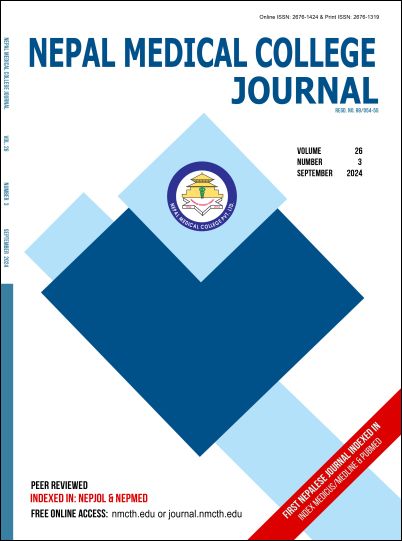Evaluation of Leiomyoma: A Clinicopathological Study in a Tertiary Care Center in Kathmandu
DOI:
https://doi.org/10.3126/nmcj.v26i3.69886Keywords:
Uterine leiomyoma, clinical features, histopathological examination, degenerative changesAbstract
Uterine leiomyoma is one of the common gynecological benign tumors. It is usually observed in female of reproductive age group and often presented with symptoms like abdominal pain, dysmenorrhea and fertility disorders. Hysterectomy and myomectomy are the procedure for management of uterine leiomyoma. The prime objective of our study was to evaluate the demographic distribution and clinicopathological changes in hysterectomy and myomectomy specimens with leiomyomas. A descriptive hospital based cross-sectional study was conducted in the Department of Pathology, Nepal Medical College Teaching Hospital (NMCTH), Nepal from May 2023 to October 2023. A total of 57 uterine leiomyoma samples received in the department of Pathology for histopathological examination were included in the study. Ethical approval for the study was obtained from Institutional Review Committee of NMCTH and informed consent was taken from each patient. The tissue biopsies were routinely processed and stained with Hematoxylin and Eosin (H and E). The observed findings were managed in MS Excel sheet and later analyzed using SPSS 17. The most common age group diagnosed with uterine leiomyoma was 41 to 50 years (64.9%). The leiomyomas were highly prevalent in women from Janajati community (47.4%). Pelvic pain, menorrhagia and bleeding disorders were the most frequent clinical manifestations. Intramural was the commonest site (77.2%) and the hyalinization was the most usual secondary changes (19.2%) found. The correlation between age distribution and site of leiomyoma, age distribution and secondary changes and site of leiomyoma and secondary changes were statistically not significant. However, detailed histopathological examination gives many information related to leiomyoma and it is necessary for the effective management.
Downloads
Downloads
Published
How to Cite
Issue
Section
License
Copyright (c) 2024 Nepal Medical College Journal

This work is licensed under a Creative Commons Attribution 4.0 International License.
This license enables reusers to distribute, remix, adapt, and build upon the material in any medium or format, so long as attribution is given to the creator. The license allows for commercial use.




